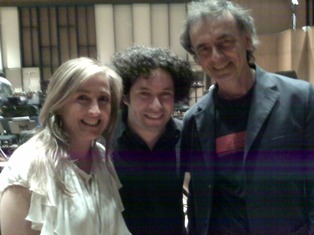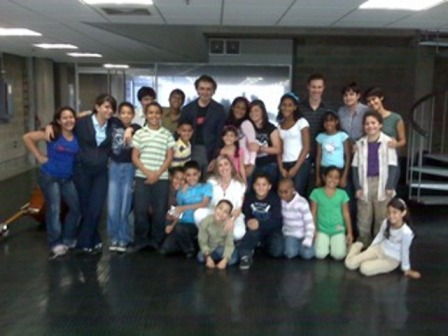Click here for Part One
Caracas, April 8, 2010
We’re here!
It seems impossible to describe all the events and feelings of just the first twenty-four hours of our trip to Venezuela, to experience and interact with El Sistema. I’ve been so long in awe of this program which is revolutionizing this country and the musical world in the best possible way–and now here we are, in its native habitat, so to speak, ready to dig in, learn, express and interact.
The fact that we are daring to interact with it in some small way has made me extremely nervous, as I’ve mentioned in my initial post. My trusty teaching artist, Richard Mannoia and I have prepared for this for many months, yet still there’s no way to really know what we’re in for.
My mood and spirit were immediately lifted by a four-year-old Venezuelan boy named Ikenna, whom I met in the flight lounge while waiting to change planes in Bogota’. I’d had on my lap the long Spanish dissertation on my composer contact, Diana Arismendi. As Ikenna and i struck up a conversation, I pulled out my little packet of colored pencils (yes, folks, I admit to carrying them around in my backpack), and he began to go to town on the cover page of my dissertation. His mother was horrified. I quickly assured her that, not only did he draw a portrait of his big sister, which told me of his feelings about her, but he “invented” an animal! A sea-going Hippopotamus with legs long enough to reach the bottom, so he could walk through the water. Needless to say, I gave him the pack of pencils, and hope he creates his portfolio. Maybe we’ll hear about “Ikenna The Artist” someday. Who knows?
I tell you, every day it seems we get confirmation that we are in the right kind of work.
On arrival in Caracas, Richard and I were met and escorted by Dani Bedoni and staff from El Sistema. The ride from the airport alone told the story: Vast shanty-towns, Barrios, perched on the steep hills outside town, swarming for miles–contrasted with the glittering towers of Caracas’s financial and political center. Political and revolutionary posters and graffiti everywhere.
But no time to reflect, tour or get acclimated. (Richard and I both contracted colds from the flight.) Right the next day our Very Young Composers classes begin. However, the unexpected is a part of life here, along with the efficient and the ambitious: I am told that instead of six to eight kids, we will be working with upwards of 30. And of varied ages from 8 to 14. I’m a bit thrown by this. (Dani says: El Sistema like to think big!) Also, Diana Arismendi, who is to be our composer/organizer, will not be here until next Tuesday, as she is giving a seminar in Puerto Rico.
However, we have Pedro and Rosa, two grad student composers to help us, and as always, Dani is there to organize, smooth and prepare. And the kids are bright-eyed, eager, and full of energy. Despite considerable study of Spanish in recent months, I find it hard to understand them when they speak quickly, and Dani and Pedro are very helpful in that regard. (I speak Italian, but it doesn’t seem to help all that much.)
Richard and I had sent out a video on YouTube for the students to prepare for us, and part of that was an assignment: “Tell us about a dream you have, whether a sleeping one or a conscious one.” Most of them chose the latter, and when they got up, we heard repeatedly: “My dream is of me standing in front of a big audience and playing the Violin. . . I dream of being a great composer. . . I dream of flying up with the birds, above the mountains. . .”
Another part of the assignment was to write something: “four sounds,” or a melody, for clarinet and/or bass. Richard and I both demonstrated our instruments and I let many of them play some notes on my bass. The melodies or sounds that the children wrote were, as I expected, fascinating and original. However, it seemed as if many of them either hadn’t written anything, or were shy to give us what they had. I suspected the latter. Also, several of them submitted pieces they were playing in orchestra, instead of their own.
Then some rhythmic games were played, passing around from student to student, and right away here I could see how brilliant Richard is at his work with kids. I followed with my “Ear Fantasy” game, in which chords (major, minor, diminished, etc) are played and identified by emotion rather than by name.
Fun! They seemed to be getting over some shyness.
All of them have quickly become favorite personalities of ours. Love ’em! Right away, one named Jose’ Gregorio, a very small nine-yr -old, brimming with energy, got up on a chair and played my bass – the bass part to the Hallelujah Chorus! He did the entire thing by memory. His hands were so small that he couldn’t stretch a whole-step, and it came out in D minor, if you can imagine that.
We gave them mostly individual assignments for the next day, to work on their music, and the three-hour class came to an end. It was clear that we would have to separate the older from the younger kids in some way, at least in breakout sessions, and also that the pitch and rhythms that I know must be in their bodies must be somehow encouraged to come out. (Just look at the way they move and swagger!) They are used to being disciplined and told what to do.
How to free up the creative consciousness without losing the incredible benefits of the discipline?
Of the many core values of El Sistema, is the primary goal of saving the child. So many of them are at-risk, impoverished children, from broken homes, and this program cares for them and gives them a supportive environment. I am told that abuse of children is not a major issue here. Perhaps this is why I don’t right away see a lot of anger, as we often see in some of our schools. But it’s too early to tell much, really.
We do know that once a child is “saved,” that an amazing and successful effort is made to achieve musical excellence.
Gustavo Dudamel is in town, and tomorrow morning, we get to go and hear his rehearsal of the Mahler 7th in the Teresa Carreño Theater, which I remember playing in, years ago, with the New York Philharmonic. This will be the first time performing this piece both for him and for the Simon Bolivar Youth Orchestra ( the “B” orchestra–the younger of the two.)
This I gotta hear!
–Jon Deak
Click here for Part Three
**************************************************************************************************************
Jon Deak, born in the sand dunes of Indiana of East European parents, is a Composer, Contrabassist, and Educational pioneer. Educated at Oberlin College, the Julliard School, the Conservatorio di Santa Cecilia (Rome) and the University of Illinois, he joined the New York Philharmonic and served as its Associate Principal Bassist for many years, while continuing his professional composing, and studying with Pierre Boulez and Leonard Bernstein. During this time he also introduced ground-breaking performance techniques for the Contrabass, and in his orchestral writing, working with major orchestras across the country.
From 1994 – 97 he served as Composer In Residence (sponsored by Meet the Composer) with the Colorado Symphony under Marin Alsop, which is where he initiated the public school program now called The Very Young Composers (VYC).
With support from the New York Philharmonic and others, the VYC has grown steadily, winning a national award for excellence in 2004. The program has been introduced in Shanghai, Tokyo, and now in Venezuela, besides serving hundreds of children in eleven New York area Public Schools and such places as New England and Eagle County, Colorado. The New York Philharmonic has premiered 42 works for children, fully orchestrated by the children themselves, mostly under the ages of 13, as well as hundreds of chamber works in the public schools and libraries.

Daniela Bedoni, Guztavo Dudamel, and Jon Deak

Daniela Bedoni, Richard Mannoia, and Jon Deak with children from El Sistema
 blog | AJBlog Central | Contact me | Advertise | Follow me:
blog | AJBlog Central | Contact me | Advertise | Follow me: 

